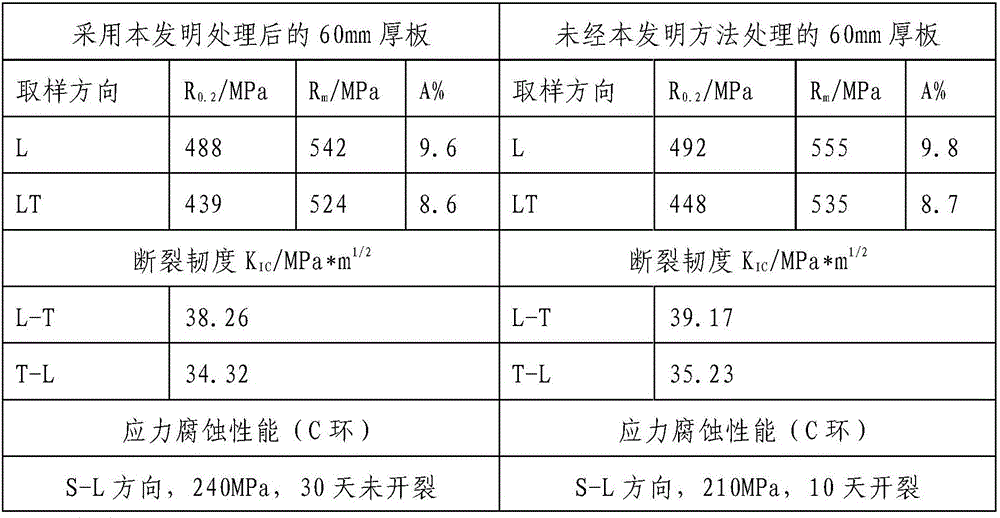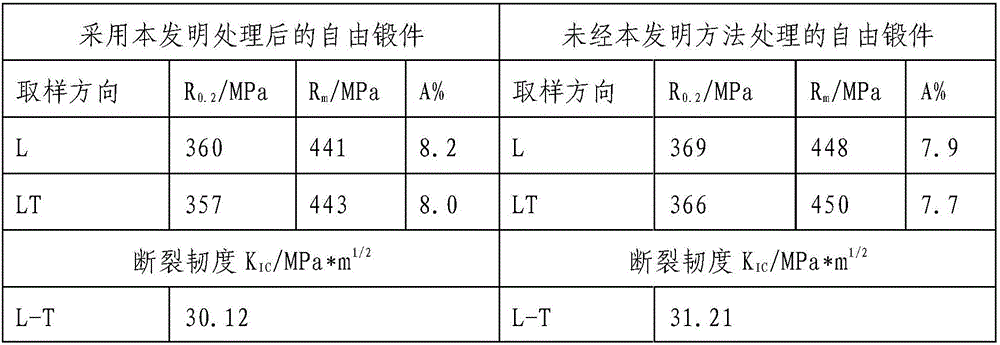Method for improving stress corrosion resisting performance of aluminum lithium alloy
A corrosion performance, aluminum-lithium alloy technology, applied in the field of heat treatment process that can improve the stress corrosion resistance of aluminum-lithium alloys, can solve the problems of reducing the stress corrosion resistance of the alloy, cracking, and affecting the application range of the alloy, so as to improve the stress corrosion resistance The performance, the process is simple and feasible, and the effect of industrialization is strong
- Summary
- Abstract
- Description
- Claims
- Application Information
AI Technical Summary
Problems solved by technology
Method used
Image
Examples
Embodiment 1
[0015] Using the method for improving the stress corrosion resistance of aluminum-lithium alloy deformed products involved in the present invention, the alloy composition and weight percentage are: Cu 3.85%, Li 1.52%, Mg 0.43%, Zn 0.50%, Mn 0.42%, Zr 0.11% , Sc 0.08%, Ti 0.06%, Si 0.06%, Fe 0.08%, the balance is Al, and the hot-rolled plate with a thickness of 80mm is annealed. The annealing temperature is 465°C, the holding time is 4h, and the cold Rapidly cool to 240°C with the furnace, and air-cool after taking out the furnace. After cooling to room temperature, the cold rolling treatment with a total deformation of 25% is carried out on the rolling mill, and the final thickness is 60 mm. Then, the plate is subjected to solution treatment at 520 ° C, the holding time is 270 min, and water is sprayed and quenched at room temperature. After quenching, the plate is pre-stretched at 4.0%, and artificially aged at 150°C for 28 hours to measure the tensile, fracture properties an...
Embodiment 2
[0020] Using the method for improving the stress corrosion resistance of aluminum-lithium alloy deformed products involved in the present invention, the alloy components and weight percentages are: Mg 4.25%, Li 2.20%, Mn 0.21%, Zr 0.11%, Sc 0.08%, Ti 0.06% , Si0.07%, Fe 0.08%, the balance is Al, a 1m long section is taken from a free forging with a thickness of 50mm for annealing treatment, the annealing temperature is 380°C, the holding time is 3h, and the cooling rate is 25°C / h. Cool with the furnace To 260 ℃, out of the oven and air-cooled. After cooling to room temperature, the cold pressing treatment with a total deformation of 18% is carried out in the forging press, and then the free forging is subjected to solution treatment at 500°C, the holding time is 160min, and water quenching at room temperature. After quenching, the forgings were subjected to 1.5% cold compression, and then artificially aged at 120°C for 30 hours to measure the tensile, fracture properties and s...
Embodiment 3
[0026] The method for improving the stress corrosion resistance of aluminum-lithium alloy deformed products involved in the present invention has the following alloy components and weight percentages: Cu 3.60%, Li 1.10%, Mg 0.40%, Zn 0.20%, Mn 0.35%, Zr 0.11%, Ag0.45%, Ti 0.06%, Si 0.06%, Fe 0.08%, the balance is Al, and the hot-rolled plate with a thickness of 120mm is annealed. The annealing temperature is 480°C, the holding time is 6h, and the cooling rate is 40°C / h. Cool down to 220°C with the furnace, and air-cool after taking out the furnace. After cooling to room temperature, the cold rolling treatment with a total deformation of 20% is carried out on the rolling mill, and then the plate is subjected to solution treatment at 530°C, the holding time is 430min, and room temperature water spray quenching. After quenching, the plate is pre-stretched by 4.3%, and artificially aged at 150°C for 20h, and the tensile, fracture properties and stress corrosion properties (C ring)...
PUM
 Login to View More
Login to View More Abstract
Description
Claims
Application Information
 Login to View More
Login to View More - R&D
- Intellectual Property
- Life Sciences
- Materials
- Tech Scout
- Unparalleled Data Quality
- Higher Quality Content
- 60% Fewer Hallucinations
Browse by: Latest US Patents, China's latest patents, Technical Efficacy Thesaurus, Application Domain, Technology Topic, Popular Technical Reports.
© 2025 PatSnap. All rights reserved.Legal|Privacy policy|Modern Slavery Act Transparency Statement|Sitemap|About US| Contact US: help@patsnap.com



